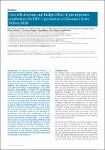Cost-effectiveness and budget effect of pre-exposure prophylaxis for HIV-1 prevention in Germany from 2018 to 2058
van de Vijver, David A M C
Richter, Ann-Kathrin
Boucher, Charles A B
Gunsenheimer-Bartmeyer, Barbara
Kollan, Christian
Nichols, Brooke E
Spinner, Christoph D
Wasem, Jürgen
Schewe, Knud
Neumann, Anja
Background
Pre-exposure prophylaxis (PrEP) is a highly effective HIV prevention strategy for men-who-have-sex-with-men (MSM). The high cost of PrEP has until recently been a primary barrier to its use. In 2017, generic PrEP became available, reducing the costs by 90%.
Aim
Our objective was to assess cost-effectiveness and costs of introducing PrEP in Germany.
Methods
We calibrated a deterministic mathematical model to the human immunodeficiency virus (HIV) epidemic among MSM in Germany. PrEP was targeted to 30% of high-risk MSM. It was assumed that PrEP reduces the risk of HIV infection by 85%. Costs were calculated from a healthcare payer perspective using a 40-year time horizon starting in 2018.
Results
PrEP can avert 21,000 infections (interquartile range (IQR): 16,000–27,000) in the short run (after 2 years scale-up and 10 years full implementation). HIV care is predicted to cost EUR 36.2 billion (IQR: 32.4–40.4 billion) over the coming 40 years. PrEP can increase costs by at most EUR 150 million within the first decade after introduction. Ten years after introduction, PrEP can become cost-saving, accumulating to savings of HIV-related costs of EUR 5.1 billion (IQR: 3.5–6.9 billion) after 40 years. In a sensitivity analysis, PrEP remained cost-saving even at a 70% price reduction of antiretroviral drug treatment and a lower effectiveness of PrEP.
Conclusion
Introduction of PrEP in Germany is predicted to result in substantial health benefits because of reductions in HIV infections. Short-term financial investments in providing PrEP will result in substantial cost-savings in the long term.
Dateien zu dieser Publikation

